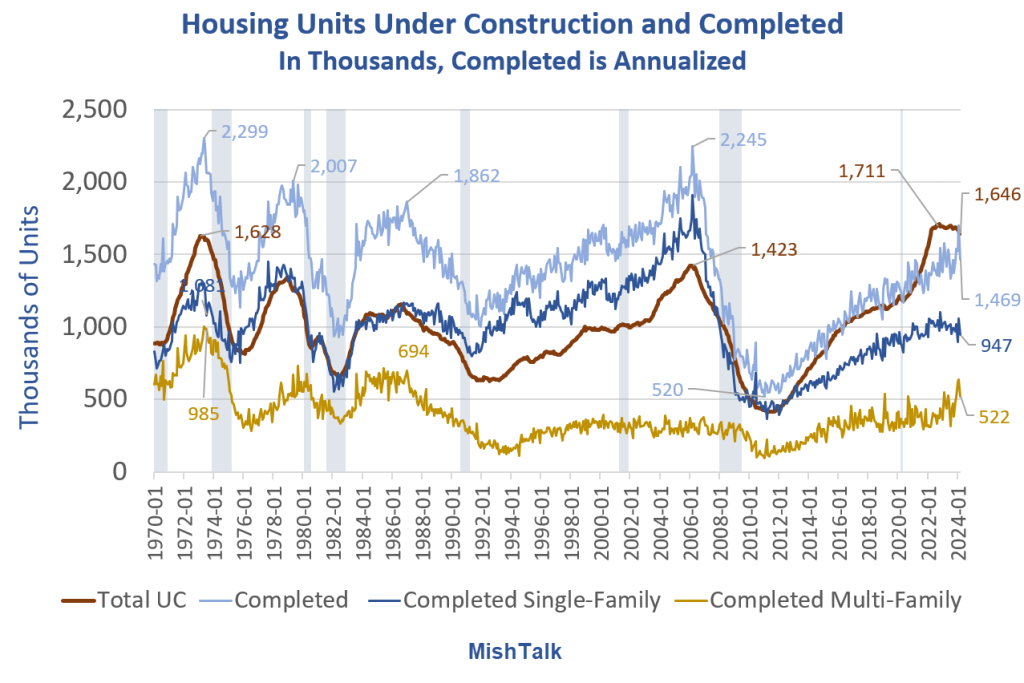The number of housing units under construction topped 1.4 million in August of 2022 and has been there ever sense. When does that matter?

Housing Units Under Construction and Completed

The number of completed units is nowhere close to four previous peaks.
For two years of longer analysts have been predicting a collapse in the price of rent based on units under construction. Some insists it’s already underway but the BLS is lagging.
The CPI Rose Sharply in March
The CPI rose 0.4 percent in March. Rent is up another 0.4 percent in March with gasoline up 1.7 percent. Together, the pair was about half of the total rise.

On April 10, I commented The CPI Rose Sharply in March Led by Shelter and Gasoline
I repeat my core key theme for over two years now. People keep telling me rents are falling, I keep saying they aren’t.
Rent of primary residence, the cost that best equates to the rent people pay, jumped another 0.4 percent in March. Rent of primary residence has gone up at least 0.4 percent for 31 consecutive months!
The “rents are falling” (or soon will) projections have been based on the price of new leases and cherry picked markets. But existing leases, much more important, keep rising.
Only 8 to 9 percent of renters move each year. It’s been a huge mistake thinking new leases and finished construction would drive rent prices.
BLS Surveys Every Six Months
That means the BLS lag should be about six months. If there is an addition impact based on completions that will show up too.
Since most leases renew in the months of May-August, it may still take a few months before we see abatement in rent prices.
Housing units completed and Under Construction vs Rent

There is little correlation between rent and completions. Nor is there a strong correlation between rent and recessions.
It really comes down to whether or not supply has outpaced demand. That is what Jay Parsons discusses in this Tweet.
Here are the top 15 markets for apartment demand in the past 12 months. These are some very big numbers, and yet… not enough to keep pace with supply anywhere– even outside the Sun Belt.
No, it’s not because would-be homebuyers are renting instead. Remember those folks are 1) likely already renters and therefore not net new, and 2) renters aging out of apartments are more likely to end up in SFR if not buying. This more likely corresponds to rapidly improving consumer sentiment (combined with wages outpacing rents for 15 straight months) pulling more young adults out of the nest or out of shared housing.
But the supply/demand gap is interesting and reflects the realities of supply hitting 40-year highs and soon to hit 50-year highs. Lots of demand, but even more supply. Will likely be 2025-26 in most markets before demand outpaces supply again (as starts have plunged over last year), which means occupancy and rent rebounds are likely still a ways out.
I have no information on how those numbers are calculated. Also, demand not > supply does not imply supply > demand. They could be equal or close.
Nor do I know the propensity of people to move to get a better deal. I would not move to save one months rent. Moving is a hassle.
But if a place is much cheaper and has a better location or better amenities I would move and I believe so would others.
Here’s another key point that I have discussed before: Large property managers now set rents by algorithm.
Before algorithms, property managers hated to see a vacant unit. Now they live with 5 percent vacancies if the algorithm says that maximizes profits.
Looking Ahead
Given that rent has risen at lease 0.4 percent for 31 consecutive months, there is going to be a pullback at some time. Those wanting to bet on a Goldilocks CPI number, may wish to do so in May or June.
If there is favorable data for June and July, the Fed may cut then.
There will not be a cut in May. Odds of a June cut are down to 16 percent. July is down to 43 percent.
But it’s not just rent. The Fed will be looking at other services and it cannot totally ignore gasoline without being accused of politics.
New Residential Construction
Housing starts plunged in March, but for the past year, it’s really a tale of two markets, single-family vs multi-family.

For more discussion of the latest residential construction report, please see Housing Starts Plunge 14.7 Percent, Multi-Family Very Weak For a Year
The 30-year mortgage rate is back up to 7.50 percent according to Mortgage News Daily. That will put a damper on things.
